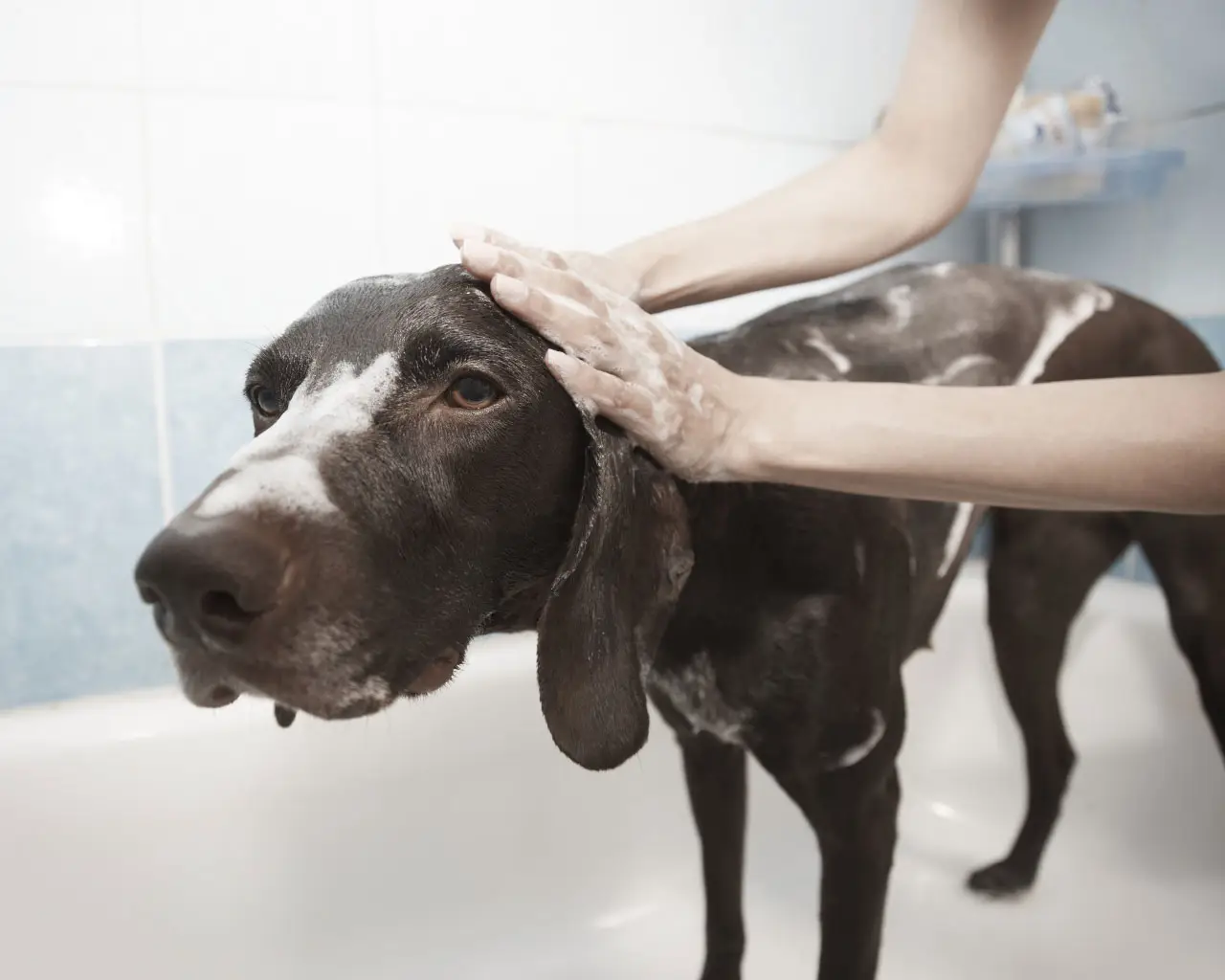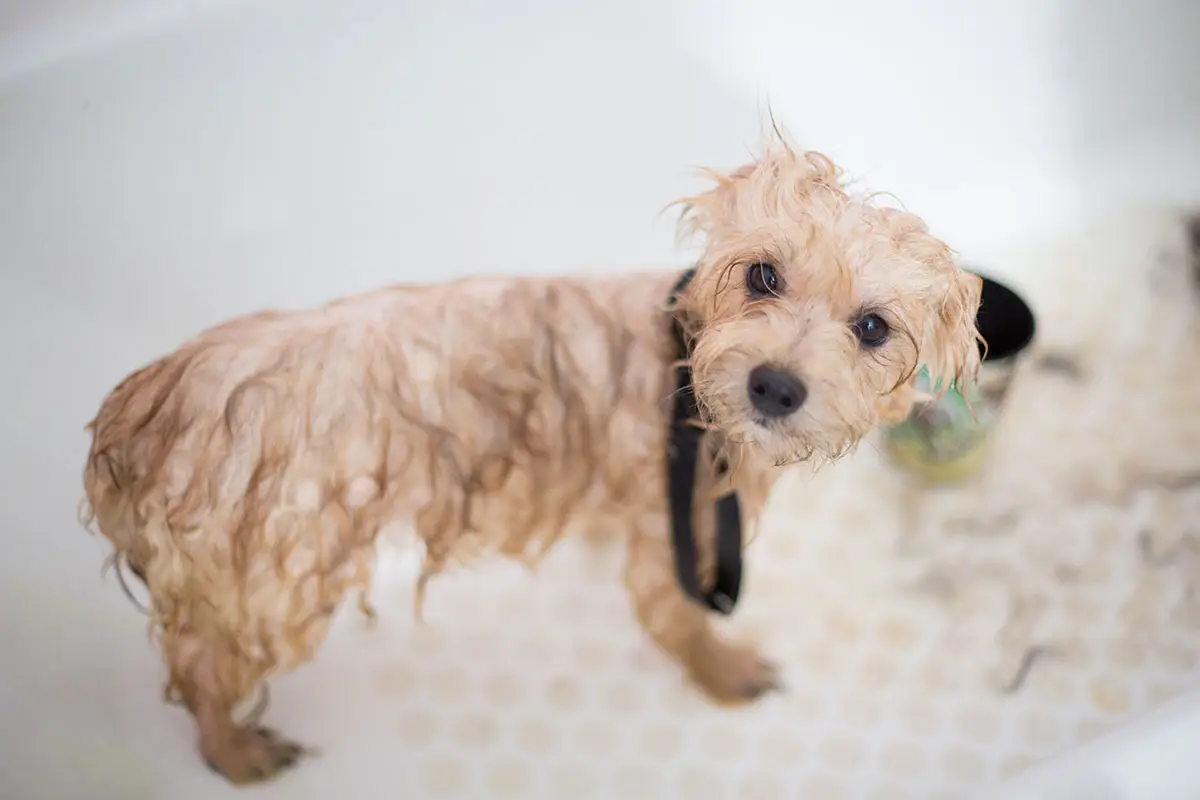Are you noticing your best furry friend scratching incessantly, looking distressed? It could be mites—a common yet aggravating issue for dogs.
Today we’ll learn how to identify, treat, and prevent mite infestations effectively, ensuring the health and comfort of your canine companion.
Get ready to tackle this problem head-on for a happier, mite-free pup.

Source: sencesense.wordpress.com
Recognizing Mite Infestation in Dogs
Recognizing a mite infestation in your dog involves identifying specific symptoms associated with different types of mites:
- Hair loss from Demodex mites
- Intense itching and spreadable mange from Sarcoptes mites
- Skin disease around the eyes and feet caused by Demodex mites
- Itchy ears from ear mites
Spotting the signs of mites is crucial for early intervention, and you’ll want to visit your vet if you suspect your dog has mites.
Mites in dogs can cause a variety of symptoms, but some of the most common are skin and hair loss, redness, and intense itching. Irritation around the eyes and feet may suggest a Demodex mite infestation, while itchy ears can indicate ear mites.
If your dog’s itching is severe and they’re losing hair, Sarcoptes mites may be the culprit.
Types of Mites Affecting Dogs

There are several types of mites that can affect dogs, each with its own unique characteristics and associated symptoms.
The most common types of dog mites include the Sarcoptes scabiei mite, causing sarcoptic mange.
Scabies is a mite infection caused by Sarcoptes scabiei, and it can be transmitted to humans and other dogs. After infection, these mites will burrow themselves deep in the skin and cause red scaly skin, constant itching, hair loss, and secondary skin infections (lesions).
It is very hard to diagnose this infection because mites are located deep in the skin and the skin scrapes from infected animal rarely show positive for this infection. The symptoms will first show in areas with thin hair, such as armpits and groins.
Next, there’s the Demodex canis mite, causing demodectic mange. These mites burrow into your dog’s skin, causing intense itching and discomfort. Most dogs will develop immunity to infection caused by this mite.
The problem occurs when dogs’ immune system becomes endangered. From that moment, mites will cause hair loss, skin thickening, and in a worst case scenario, secondary infections with other organisms like bacteria and yeast (lesions, anal gland infections, etc). The infected dogs will not itch unless they enter the phase of secondary infections.
Another type of mite, Otodectes cynotis, infests the ears and can lead to severe infection if not treated promptly.
Yet another, the Cheyletiella yasguri mite, causes a condition known as walking dandruff in dogs.
The walking dandruff is a disease caused by mites that live their whole life cycle on a dog. They look like a dandruff flake, and you can see them move on the fur.
They will cause intense itch, and in an advanced stadium of infection, the skin will be covered in a red rash. It is very easy to diagnose them under the microscope, but there is no special treatment for them.
How Dogs Contract Mites

Your dogs can contract mites through direct contact with another dog already harboring mites. Mites on dogs can easily transfer from one to another, particularly in close quarters like kennels, grooming salons, or dog parks.
Sarcoptes mites, for instance, are highly contagious and can quickly jump from a host dog to your pet, leading to skin disease that can cause severe itching and discomfort.
Mites can also infest a dog’s ear, leading to what’s commonly known as ear mites. These typically spread through physical contact as well.
Apart from other dogs, your canine companions can also contract mites from their environment. If your dog loves to roll around in the grass or dig in the dirt, they’re exposing their skin and coat to potential mite infestation.
Symptoms of Mite Infestation

While your dog may seem perfectly happy rolling in the grass or digging in the dirt, these activities can expose them to mites, leading to a variety of symptoms that are crucial to identify and address. These symptoms can include red skin and hair loss, intense itching, and often shaking the head. If you notice these signs, it’s possible your pup is dealing with a mite infestation.
These joint-legged invertebrates can cause a range of issues in dogs, and the symptoms can vary depending on the type of mite. For instance, Demodex mites can cause hair loss, skin thickening, and infections while Sarcoptes mites result in intensely itchy skin, hair loss, and skin infections. Ear mites, on the other hand, cause scratching, head shaking, and an unpleasant odor from the ears.
Understanding the symptoms of mite infestation is the first step in knowing how to get rid of mites in dogs. If you think your dog may be infested, consulting a vet is crucial. They can provide an accurate diagnosis and help your pup out by prescribing the appropriate treatment.
Diagnosing Mites in Dogs

Once you’ve identified potential symptoms of a mite infestation in your furry friend, the next crucial step is getting a definitive diagnosis from a vet.
Diagnosing mites in dogs can be a simple process if the mites are ear mites, as these are visible in the ear canal. However, demodex mites and sarcoptes scabiei mites aren’t so easily spotted.
Your vet will perform a thorough examination of your pup. They may take a skin scraping or pluck hairs for microscopic examination. This will help identify the specific type of mite causing the discomfort. If you’ve noticed your pup excessively scratching their ears, the vet may also do an ear swab to check for ear mites.
In some cases, your vet might suggest a trial treatment. This means treating your dog for mites even if the diagnosis isn’t 100% certain. If your dog’s symptoms improve, it’s a good sign that mites were the problem.
How To Treat Dogs With Mites? Effective Treatment Methods
To effectively treat mites in your dog, it’s crucial to visit a veterinarian for a definitive diagnosis and to explore suitable treatment options tailored to your dog’s specific type of mite infestation. Your vet will help you understand the effective treatment methods that can help cure your dog. These might include medications like afoxolaner, fluralaner, lotilaner, and sarolaner for Demodex mange, or heartworm medication like ivermectin for Sarcoptic mange.
Some effective treatment methods to consider:
- Prescription products: Products like Bravecto and Nexgard Spectra are often recommended for their ability to kill mites and manage infestations effectively.
- Bravecto: An oral chew that can be used for dogs over 6 months old.
- Nexgard Spectra: A chewable tablet effective against fleas, ticks, mites and worms.
- Medicated washes: In severe cases, your vet might suggest medicated washes performed in a vet clinic.

There are also many antiparasitic shampoos on the market nowadays that can help you get rid of these stubborn parasites at home.
Attention – your dog might be allergic to shampoo. Be prepared to have them tested to allergies if the pooch starts behaving odd when in contact with the shampoo.
You can buy them at almost all pet shops, but if you decided to do this kind of treatment, always consult your vet before purchasing a shampoo on your own. Same goes for Animax ointment – a popular term in this space lately. Please be diligent.
My Personal, Easy-To-Do Homemade Mites Treatment
After years of working with dogs, I found out the perfect recipe to treat mite infections, and today I am going to share this recipe with you. The treatment plan is remarkably simple, and it does not require a whole lot in the way of materials.
You will need:
- Hydrogen Peroxide – 1% is best if you can find it immediately, but any solution 3% and under will do just fine. If you can’t find the 1% solution, I will show you how to dilute it to the proper concentration in the following section.
- Borax Powder – It is all about the Borax. It is our main ingredient, but you don’t need to purchase a lot.
- Water
- Your Dog’s Cooperation – Unfortunately, for many owners, this will be the hardest part.
- A soft cone for your dog – Optional
This really shouldn’t end up being too expensive of an affair, and if the treatment works properly, then you’ll also be saving some money on veterinarian bills at the end of the day.
Borax is mostly sold as a detergent, and it’s pretty easy to find it in stores. If you’re really stretched and can’t find it, then you can buy it online in bulk amounts for an affordable price.
The soft cone is labeled as optional, but if your dog licks itself frequently no matter what the consequences might be, then it’s time to make the investment. They can be found online or at your vet’s office without breaking the bank.
Just follow these few simple steps and I guarantee you that in no time the mite infections will be a past.
1. Create The Base For The Solution
Now, if your dog has mites, make sure not to panic. Acquire all the chemicals I listed above, and you are ready for action.
Your first step is going to be to mix the base for the solution. Calm down; this isn’t rocket science, trust me – you will do fine.
The hydrogen peroxide solution I mentioned above should be at 1% before you proceed with mixing. So if you were unable to purchase a solution at that exact concentration, you’d need to dilute the one you have. You’ll do that with adding enough water to bring it to roughly that level.
Most solutions are sold at 3%, so the simple addition of two parts of water to one part of the chemical will be enough to get you at the right concentration. For instance, if you take one cup of peroxide, you will need to add two cups of water to dilute it.
2. Finish The Solution
After this, it is time to add the Borax. Add a tablespoon of the powder for every two cups of the solution you’ve made. It’s best to make up at least 1.5L(or six cups) at a time in order to have enough for the treatment itself.
Larger dogs will require more, and particularly small dogs may not require as much. You can always store the excess if you make more than necessary. I will rather advise you not to worry too much about making an exact amount because you never know when you will need it again.
Borax can sometimes be notoriously hard to dissolve in solution. It should dissolve pretty well if you use one tablespoon per 500mL of solution. But if you’re still having trouble with getting it to dissolve, then the key is in gently warming the solution and stirring.
I know what you’ve been thinking, but a stove or microwave is no good in this operation. High temperatures will downsize the amount of hydrogen peroxide, or it can even remove it completely.
Instead, place the solution on a window sill or somewhere else where it can get direct sun for an hour or so and come back to stir it. You’ve now got yourself a pretty effective treatment on your hands, and it’s time to use it.
3. Apply The Treatment
Before applying the Borax treatment, shampoo your dog using good quality dog shampoo. Never use a shampoo that is made for human use because it is not ph-balanced for your dog’s skin and can make the inflamed skin situation worse.
After you thoroughly washed your dog (particularly pay attention to areas under the armpits and groins), double-rinse the pooch. This way, you will make sure you remove all shampoo residue.
The treatment is amazingly easy to apply. Use the measuring cup to apply the solution all over your dog’s fur. Make sure your dog’s fur is soaked in it, especially around tail and paws. Make sure to apply it even in areas where the symptoms aren’t present in order to ensure that you kill all of the mites you can.
The tricky part is how to apply the solution on your dog’s face.
Pour a small amount of solution in your hands and carefully apply it all over its face; make sure no solution comes in contact with the doggo’s eyes. If, in any case, your boy has lesions, no matter if they are bleeding or not, make sure you don’t massage the solution in those areas.
Don’t rinse the solution off with water at the end of the session; you’ll need to leave it on in order to maintain its efficacy. This does present a complication; however, if your dog licks enough of the solution off of himself, it can cause him to become mildly ill.
Since none of us are big fans of dog vomit on the floor or sick pooches for that matter, you’ll want to make sure to find some way to prevent your pupper from licking himself until the solution is settled in.
Many people opt to use those cones you get from the vet when your dog gets stitches – they’re readily available online and make for a simple solution. Most dogs won’t like it much, but it’s better than letting them get ill by a long shot.
Pro tip: Never use the hairdryer. Don’t towel the dog off if you don’t need to, use the towel only if it’s cold outside and your dog must remain in a warm room. The best way is to let it dry naturally in the sun. After Borax bath, always apply some kind of lotion because it can be pretty dehydrating for the skin.
4. Disinfect Your Home

The hard stuff is mostly over at this point. The easiest way to disinfect your home is hardly going to be a surprise at this point. Sprinkle some borax powder on your carpets and around the house – in general, sprinkle anywhere you think mites might be hiding.
It’s probably best to apply some extra powder to all the places you know your dog often visits when he wants to take a quick nap or lay down to chill. After you apply the Borax powder, make sure you leave it in for at least 24 hours and then vacuum it.
It is crucial to disinfect your dog’s grooming tools; spray them with some of the leftover solution from the medicated bath. Wash your dog’s bedding, towels, and blankies in hot water with one cup of Borax and dry it in the dryer on the highest setting.
If you have any other pet that may come in contact with your infected dog, consider a Borax bath for it at least one time following the first month of infestation.
Some people go so far as to cover their furniture and go through all sorts of protocols, but in a lot of cases, they’re just going overboard. Feel free to do so if you’d like, but as long as you give it a good shot, you’re likely to be able to prevent re-infestation for your unfortunate dog.
Pro tip: Right now might be a good time to keep your dog in a single room that you disinfected before applying the solution. Ingestion of borax powder by a curious dog is just going to make them sick.
5. Repeat The Treatment

With all of that done, you’ll want to repeat the treatment once or twice a week for a few weeks. At this point, they should be showing obvious signs of getting better, and their hair should be coming back in.
I found that this schedule works best:
- Week 1 – Use the Borax bath every other day
- Week 2 – Use the Borax bath every 3 days
- Week 3 to 6 – Only once a week
- Week 6 to 12 – Once a week every other week
Remember not to let your dog ingest any of the borax solutions, and you’ll be fine. But just to be sure, I will list you the symptoms that may occur if your dog ingests the Borax:
- diarrhea
- loss of appetite
- vomiting
- convulsions
If you notice any of these after the Borax treatment, you’ll know why it happened.
It might seem a bit tedious to repeat this without absolutely immediate results, but unfortunately, dog medicine, much like human medicine, rarely just works without any complications right off the bat.
Dog Mites Prevention Tips

You can easily get ahead of mite infestation and ward them off by taking everyday precautions that will help keep your pooch healthy and hygiene at maximum.
When you are giving a bath to your dog, use all-natural pet shampoos. Always make sure that water won’t come in contact with your dog’s ears because excessive moisture can cause ear infections. Fresh water and high-quality food are crucial. The food must strengthen your dog’s immune system, not the opposite. You can even opt to include some immune-boosting supplements.
Always remember to wash your dog’s bedding and any toys, rugs, collars, or leashes they frequently use, as these can harbor mites. If your dog has a long coat, make sure you are getting it brushed and combed each week and trimmed when necessary. If you decided to sign your dog to daycare, make sure you are well informed about their sanitary standards.
Make sure its clothes are also clean, and change them often – both you and your dog will love having fancy-looking clothes!
There is nothing nobler than adopting a stray or a shelter dog, and I am fully supportive of that. But before taking it to his new forever home (especially if you already have a dog or a cat), take a quick trip to your vet and check if there is any sign of mite infestation.
There are a lot more natural remedies for mange diseases like apple cider vinegar, Aloe Vera, lemon, or natural honey. But use them with great caution cause some may present a great risk for your dog if ingested.
Frequently Asked Questions
How Do You Get Rid of Mites on Puppies?
To treat mites on puppies, you’ll need to consult a vet for precise diagnosis and proper medication. Depending on the mite type, treatments may include special shampoos or prescribed drugs. Always follow the vet’s instructions.
Are Mites Bad for Puppies?
Yes, mites are harmful for puppies, causing discomfort and health issues. It’s crucial to consult a vet for diagnosis and treatment. Follow their instructions diligently to eliminate mites and provide relief for your pup.
What Is the Best Treatment for Dog Mites?
Surely you’d love to see your pup itch-free. A vet’s advice is key! They might suggest meds like afoxolaner for Demodex mites, ivermectin for sarcoptic, or ear drops for otodectes. Follow their plan to a T!
How Long Does It Take a Dog to Recover From Mites?
Your dog’s recovery from mites varies, usually taking several weeks to a few months. Regular vet visits for check-ups and treatments are crucial. Maintain a clean environment and follow the vet’s instructions for best results.
How to Get Rid of Mites in Dogs – Conclusion
So, are you ready to help your pup kick those mites to the curb?
Armed with knowledge on different mite types, symptoms, diagnosis methods, treatment options, and prevention strategies, you’re now well-equipped to handle a mite infestation.
Remember, every dog is unique and requires a tailored approach. Consult your vet, apply the right treatment, and soon enough, you’ll have a happier, healthier dog.
After all, isn’t that what every pet owner wants?



I love your articles and I would love to print them and build up my own reference book, but I would like to do it without the pictures and artwork that make such an attractive presentation online. Is it possible to offer an option to print with nothing but the written words? Thank you so much for what you do for us, and for our pets